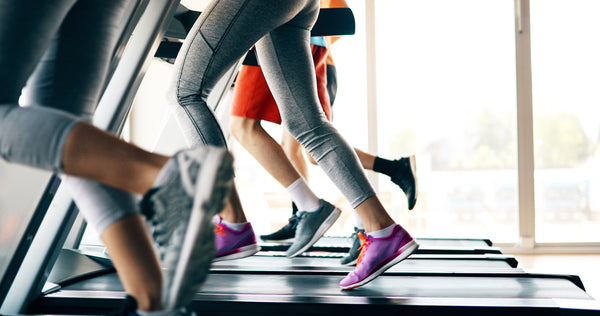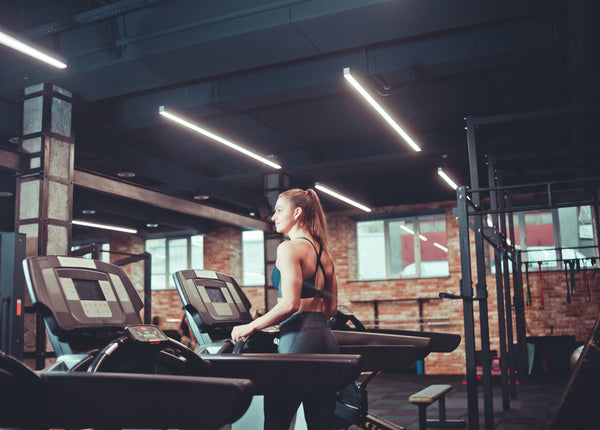(5 min read)
If you’re short on time, you’ve hit a fitness plateau or you’re just bored of running the same tired old routes at the same steady pace, a HIIT treadmill workout could be exactly what you need.
It’s not only a brilliant way to squeeze a workout into a busy day but HIIT running also improves performance, builds speed, burns fat and boosts heart health. All in a short and efficient space of time.
Want to know more? Here’s everything you need to know before you go out and HIIT the treadmill hard.
Download the ebook above.
What is HIIT running?
If you’ve been anywhere near a gym in the past few years, you’ve undoubtedly heard of HIIT. The top entry in the highly regarded American College of Sports Medicine’s fitness trends for 2014 and 2018, and the number three trend for 2019, HIIT is much more than a passing fad.
Group classes and YouTube videos are everywhere, sports scientists, personal trainers and research studies regularly applaud HIIT’s virtues, heck even your gran’s heard of it.
But what exactly is HIIT and how does it apply to running?
HIIT stands for High-Intensity Interval Training. It’s a form of workout involving short bursts of high-intensity exercise – performed at around 80-90 per cent of your maximum heart rate – followed by short periods of rest.
One of the reasons HIIT sessions are so popular is because they allow you to boost your fitness level and up your calorie burn in double quick time – around 20 minutes in most cases.
HIIT involves any form of intense activity that gets the heart rate soaring such as burpees or cycle sprints. When it comes to running short sprints and hill sprints, either outdoors or during treadmill training, count too. Anything that gets your engine revving close to max.

How can you benefit from HIIT treadmill workouts?
There are a whole host of HIIT training benefits for runners. These include:
Boosting your running performance and heart health
VO2 max, the amount of oxygen your body can process to provide energy, is a key measurement for runners. A higher VO2 max means more efficient use of oxygen resulting in improvements to your running fitness, speed and efficiency.
HIIT is a particularly good booster of VO2 max. Studies show it can increase your VO2 max by as much as 46 per cent in 24 weeks, lower your resting heart rate (the number of times your heart beats per minute when at rest, a good sign of overall fitness) and increase the amount of blood your heart pumps with every beat.
Increasing fat burn
It’s an effective way of torching fat. Studies have shown that HIIT increases the level of growth hormones in your body after exercise, which in turn can increase fat and calorie burn. HIIT also boosts your metabolism meaning you burn more calories for up to 24 hours after a workout, simply by going about your everyday business.

Time efficiency
Not got time to fit in a long run? HIIT allows you to get similar results in a shorter space of time. A recent study found that four rounds of 30-second flat out sprints, followed by four and a half minutes of recovery, were as effective as 30 minutes of steady-state cardio in improving mitochondrial function. That’s how quickly your body can turn fuel into energy, a good indicator of fitness and exercise performance.
Mental health
We all know the mood-boosting effects of a good exercise session and HIIT is a particularly good workout for the brain. High-intensity exercise can regulate your mood, improve your memory and ability to learn. It can also increase your brain’s capacity to maintain and repair itself at a greater rate than a lower intensity session.
Do HIIT workouts make sense for endurance runners?
If you’re training your body to run a long distance at a steady pace – during a marathon for example – you may be wondering how shorter, intense bursts of running will help.
Many runners already include faster intervals at race pace or threshold runs, runs which are faster than a normal run but below 5k pace, in their training but where do the shorter, faster efforts required of HIIT fit in?

Some HIIT benefits, such as increased VO2 max, are definitely more beneficial for shorter distances such as 5k and 10k.
In fact one study found runners who reduced their weekly mileage by 50 percent but introduced three interval training sessions, knocked around a minute off their 5k times after seven weeks.
Impressive.
But HIIT can still be a handy tool for the marathon runner. Adding faster bursts of running is good for building your base fitness. Long steady runs will increase the number of mitochondria in your cells – the powerhouses that turn fuel into energy – but HIIT training can also stimulate the production of mitochondria and make them more powerful. So if you haven’t got time for a longer steady-state run then a HIIT treadmill session is a good substitute.
HIIT training can also improve your overall speed by increasing your VO2 max. Adding it into the beginning of a marathon training block may mean you can train at a higher level once the longer runs kick in.
There’s also the added benefit of keeping your body guessing. It’s all too easy to get stuck in a rut of easy runs and skipping anything more challenging. High-intensity bursts will get you used to running at faster speeds, keep training interesting, help you avoid fitness plateaus and mean you’re mentally tough enough to keep pushing when the going gets tough.

HIIT training: Aerobic vs. anaerobic workouts
There are two main types of training – aerobic and anaerobic. Aerobic exercise uses oxygen, can be performed for longer durations and is where most of your steady-state cardio runs fit in. Anaerobic exercise is performed without oxygen at around 80-90 per cent of your maximum heart rate.
When you’re working in the anaerobic zone you can only last up to two minutes before you have to slow or stop and you usually feel pretty sick afterwards – think sprinting round the track.
HIIT is mainly anaerobic training. While aerobic exercise is great for building endurance, anaerobic exercise helps build muscle and train your body to recover quickly from shorter bursts of intensity even on tired legs – overtaking your rival on the cross country field or smashing out that sprint finish, for example.
During an intense burst of HIIT exercise, your heart rate is elevated and your fast-twitch muscle fibres become fatigued. Your heart rate will stay elevated even as you enter your rest period and afterwards your body will have to work hard to repair damaged muscle proteins, which can result in greater muscle volume and definition.
What does a typical HIIT treadmill workout routine look like?
When you’re running outdoors setting your own pace, it can be hard to push yourself to the intensity levels needed for HIIT to be effective, which is where treadmill exercise comes in.
When the treadmill belt is spinning you have little choice but to push hard. It also saves you from having to think about hitting the right pace, leaving you free to focus solely on surviving each effort.

While you should adjust the speed, intensity, incline setting, recovery and duration of your interval workout according to your fitness, a good session to try is the 10-20-30 method.
------
Jog for 30 seconds at a light pace
Run for 20 seconds at a training pace
Sprint for 10 seconds at a fast running pace
Jog for 2:00 minutes
Repeat intervals for 2 or 3 sets
Cooldown by jogging a mile
One study found this method helped seasoned runners improve their 5k times by nearly a minute in just seven weeks.
High-intensity vs. recovery intervals
One of the main problems with HIIT is that people don’t know exactly how hard they should be pushing on the high-intensity bursts or how easy their recovery should be to allow them to go again.
Gauging effort can be a tricky business and the levels you pick will depend on your current fitness and ability but the guide below should help.
High-intensity intervals
Your high-intensity intervals workout shouldn’t be a walk in the park, you should be working at a speed, an incline or a combination of both that really pushes you. If you use a heart rate monitor you’re aiming for around 80-90 per cent of your heart rate max.
If you’re going by RPE – rate of perceived exertion – aim for at least an eight out of 10. You shouldn’t be able to talk or keep the intensity for much longer than a minute and your heart should be pounding. Sounds nice huh?
Recovery Intervals
During your recovery period, the aim is to get your heart rate to return to normal as quickly as possible, so you’re ready to go again. Try walking or jogging at your warm-up speed or slower, the kind of easy pace where you could happily have a conversation with a friend.
A common suggestion when looking at treadmill speeds is that your recovery should be three miles per hour slower than the speed of your effort. So if you were running at 8 mph (7:30 minute/mile pace) your recovery pace would be 5 mph (12:00 minute/mile pace).
Duration: How long should your HIIT treadmill session be?
This depends on your current fitness. If you’re new to exercising you may want to keep it as short as 10 minutes with a warm-up and cool down. Even for more experienced exercisers the meat of the session shouldn’t really exceed 30 minutes and most will be around 20 minutes – if you’re working at the correct intensity you won’t really be able to continue for any longer.

Frequency: How often should I HIIT it hard?
The number of HIIT sessions you add to your training schedule is a matter of choice and should be based on individual goals but be warned this isn’t something to do every day.
Because of the strain you’re putting on your body it’s advisable to leave 24-48 hours between intense workouts to allow your body to recover and prevent injury and overtraining.
You still need to make time for those steady-state runs too, as this is when your body adapts to the stresses of running for longer periods of time. A good rule of thumb for runners is one to three HIIT sessions a week.
Periodisation: When is best to add HIIT to my training?
If you’re looking to add a period of HIIT training to your schedule, building it in before your marathon or half-marathon training plan kicks in is smart. Around eight weeks of base training with some HIIT treadmill sessions will allow you to improve your aerobic capacity in a short space of time. And when you hit your race-specific training you’ll feel strong.

What about nutrition for optimal HIIT performance?
As with any form of training, you need to fuel your body properly to ensure you’re able to perform HIIT to the best of your ability and, more importantly, recover afterwards.
Pre-workout nutrition
Going into a HIIT training session when you’re running on empty means you won’t be able to reach the effort levels needed for the biggest performance gains.
Try and ensure you have a meal containing carbohydrate and protein around three to four hours beforehand and a carb and protein snack a couple of hours before for an energy boost.
Good options include wholemeal toast with nut butter, Greek yoghurt and fruit, dried fruit and nuts or a natural energy bar such as the Veloforte Avanti.
The vegan and gluten-free Avanti contains vital dual-source carbohydrates, plus natural sea salt electrolytes which help maintain muscle function — especially during tough and sweaty workouts.

Post-workout nutrition
Post-workout, your body needs carbohydrates to replace energy and protein to help muscles repair. Pitta bread and houmous, cereal with fruit and milk are all good choices.
Or for a snack on the go, try the Veloforte Forza. Made from all-natural, real-food ingredients, the Forza is designed with the perfect 3:1 ratio of carbs: protein to aid recovery after tough sessions, topping up your glycogen stores and providing 12g of complete protein for muscle building and recovery. Tastes great too.


